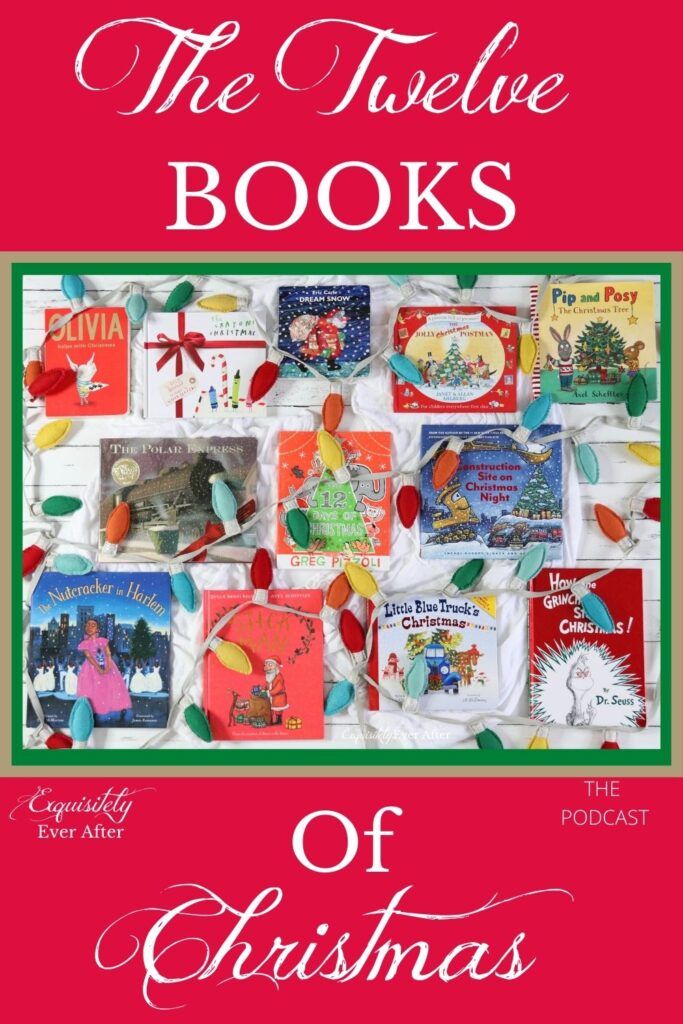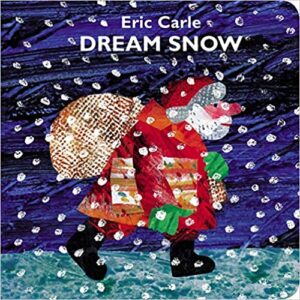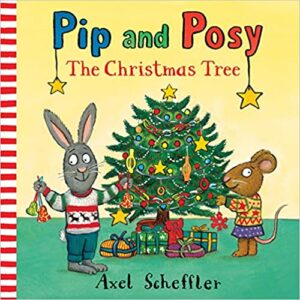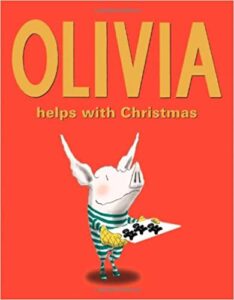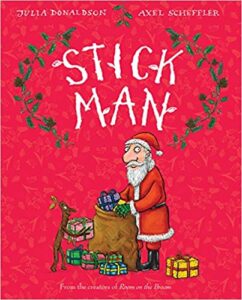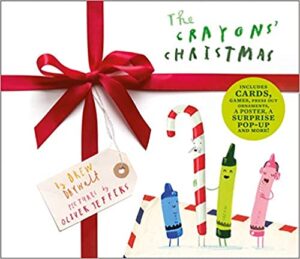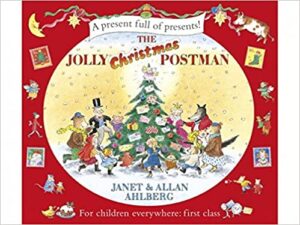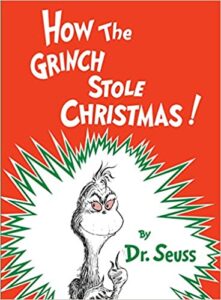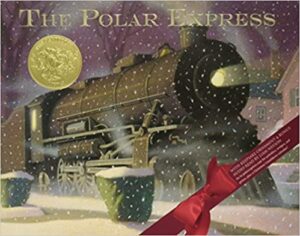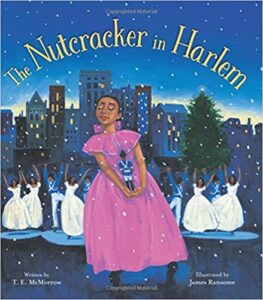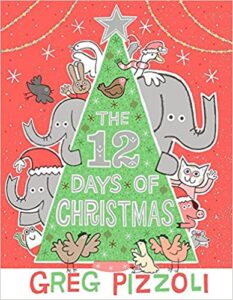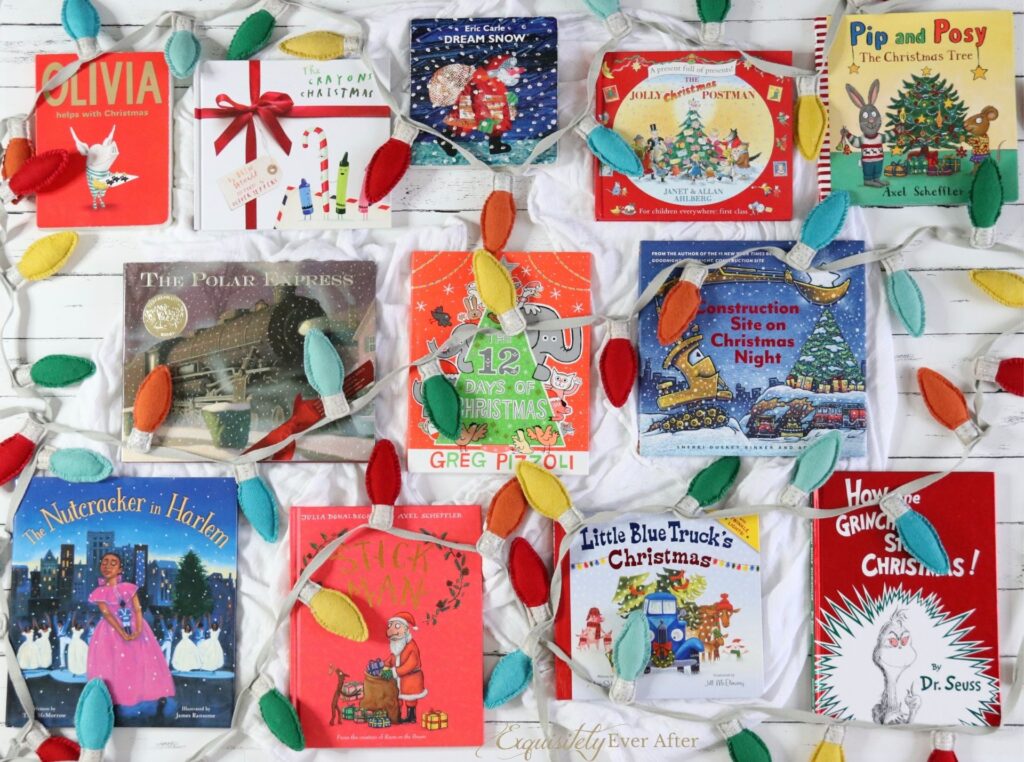
Some links are affiliate links. Please see more here.
SUMMARY: On the first day of Christmas my true love gave to me, a gorgeous stack of books beneath the tree! We’re counting down to Christmas with 12 of my family’s favorite Christmas books. In this episode, we discuss the best Christmas books for children, from board books for infants and toddlers to picture books preschoolers and kindergarteners. I also recommend a couple of interactive Christmas picture books to read with your child, as well as some classic Christmas picture books—and some twists on classic Christmas picture books—for the whole family to enjoy.
Listen to the Podcast Episode:
Books Mentioned in this Episode:
*Dream Snow by Eric Carle
Thirty Million Words: Building a Child’s Brain by Dr. Dana Suskind
*Little Blue Truck’s Christmas by Alice Schertle, illustrated by Jill McElmurry
Little Blue Truck by Alice Schertle, illustrated by Jill McElmurry
Little Blue Truck Springtime by Alice Schertle, illustrated by Jill McElmurry
Little Blue Truck’s Halloween by Alice Schertle, illustrated by Jill McElmurry
Little Blue Truck’s Valentine by Alice Schertle, illustrated by Jill McElmurry
*Pip and Posy: The Christmas Tree by Axel Scheffler
Tales from the Acorn Wood by Julia Donaldson, illustrated by Axel Scheffler
The Gruffalo by Julia Donaldson, illustrated by Axel Scheffler
Room on the Broom by Julia Donaldson, illustrated by Axel Scheffler
The Gruffalo’s Child by Julia Donaldson, illustrated by Axel Scheffler
Zog by Julia Donaldson, illustrated by Axel Scheffler
*Olivia Helps With Christmas by Ian Falconer
Olivia by Ian Falconer
*Construction Site on Christmas Night by Sherri Duskey Rinker, illustrated by AG Ford
Goodnight, Goodnight, Construction Site by Sherri Duskey Rinker, illustrated by Tom Lichtenheld
Mighty, Mighty Construction Site by Sherri Duskey Rinker, illustrated by Tom Lichtenheld
Three Cheers for Kid McGear by Sherri Duskey Rinker, illustrated by AG Ford
*Stick Man by Julia Donaldson, illustrated by Axel Scheffler
*The Crayons’ Christmas by Drew Daywalt, illustrated by Oliver Jeffers
The Day the Crayons Quit by Drew Daywalt, illustrated by Oliver Jeffers
The Day the Crayons Came Home by Drew Daywalt, illustrated by Oliver Jeffers
*The Jolly Christmas Postman by Janet and Allan Ahlberg
The Jolly Postman by Janet and Allan Ahlberg
*How the Grinch Stole Christmas by Dr. Seuss
How the Grinch Stole Christmas Audiobook
*The Polar Express by Chris Van Allsburg
*The Nutcracker in Harlem by T. E. McMorrow, illustrated by James Ransome
The Nutcracker by E.T.A. Hoffman
*The 12 Days of Christmas by Greg Pizzoli
The Watermelon Seed by Greg Pizzoli
Note: Books marked with * are the focus books of this episode.
Movies Mentioned In This Episode:
How the Grinch Stole Christmas Original Movie
Dr. Seuss’ The Grinch (Benedict Cumberbatch Grinch)
Dr. Seuss’ How the Grinch Stole Christmas Movie (Jim Carey Grinch)
Podcast Transcript:
On the first day of Christmas my true love gave to me, a gorgeous stack of books beneath the tree!
Hello Everybody! I’m so excited about today’s episode because we’re going to be talking about 12 of my family’s favorite Christmas books! My boys are SO excited for Christmas this year – James has basically turned into a festive little elf because he’s now old enough to really get into the spirit of things and even though Luke probably doesn’t remember his first Christmas last year, thanks to his brother, he has caught on to the fact that this is a special time of year and so is also a little smushy ball of joy. I’ve always loved this time of year, but now that I have my own kids, it just makes it that much more magical and since James was born, I’ve made it a point to try to do at least one fun and festive thing on each day of the 24 days leading up to Christmas. This year, of course, the holidays are going to be a little different since we are trying to do our part to protect other people by staying home and social distancing, so we won’t be doing some of our regular traditions. However, one tradition that we definitely have been continuing is reading a Christmas-themed book at bedtime every night during the Christmas advent. We read a Christmas book for each of the 24 days leading up to Christmas, but for the sake of time and because my son James has been singing the 12 Days of Christmas on repeat since Thanksgiving, today I’m just going to be talking about our current Top 12.
So because I want to give you a variety of books to choose from (and because I also have an innate, deep need to organize things), and even though all of the books can be read by kids ages 0 to 5 or 6, I’ve arranged this list by category and general age group: first up will be board books for infants and toddlers, then board books and picture books for older toddlers to preschoolers/kindergarteners, then interactive picture books for preschoolers/kindergarteners/younger elementary schoolers, and last will be some classic Christmas picture books and a couple of twists on classic Christmas picture books for the whole family to enjoy. And just so you know, I always list all of the books that I mention in the shownotes, so you don’t have to worry about pausing to write them down. You can just go to exquisitelyeverafter.com/episode19 and you’ll find that list.
First up are board books for infants and toddlers and the first book I’ve chosen is: Dream Snow by Eric Carle. This book is about an older gentleman farmer who has 5 animals: a horse, a cow, a sheep, a pig, and a rooster (named One, Two, Three, Four, and Five, respectively). They live in a barn next to a tree, which he calls, appropriately if unimaginatively, Tree. One night, the farmer has a dream that all of his animals get covered with a blanket of snow and he wakes up to realize that it actually has snowed. He hurriedly puts on his red suit, hat, and gloves, slings a sack over his back, rushes out of the house, and runs past the bewildered animals, who wonder what he’s up to. He empties his sack and decorates Tree, placing presents beneath it for all of the animals, and the book ends with the farmer shouting “Merry Christmas to all!”
There are a bunch of reasons that this is a great Christmas book for toddlers. First, there are textured dots of snow on the front cover, lift-the-flaps which reveal each animal under a snowy blanket, and shiny, textured tinsel on the decorated tree at the end of the book, that all provide your little one with a fun, tactile experience while you read. Second, this book is great for kids who are learning to identify and label animals and also for kids who are learning to count because of the animals’ numeric names. When you read this book with your toddler, you can ask her to identify each animal and also to tell you what sound each animal makes, which is a great way to work in some child-directed speech during your read-aloud session. As we’ve discussed in Episode 4, dialogic reading is so crucial for your young child’s developing verbal skills. As I talked about in that episode, the goal of dialogic reading is to encourage children to take a more active role in the reading experience by allowing them to interact with you and the book, ask questions, and talk about what they see, think, and feel. All of these conversations that you have with your child while reading are important for laying the foundation for your child’s communication skills and helping to build your child’s brain. And if you’d like to read more about dialogic reading, there is a great chapter about it in Dr. Dana Suskind’s book Thirty Million Words, which we’ve discussed before on this podcast. Again, it’s in Episode #4. I’ll link it in the shownotes.
Okay, back to Dream Snow. The third reason I think this book is great for toddlers is that little kids who are just starting to understand who Santa Claus or Father Christmas is will love seeing the farmer transform into him when he puts on the red suit, hat, and boots and slings his sack over his back. In addition to it being a fun surprise, it is also reassuring to little kids who might be a bit afraid or overwhelmed by Santa to see him in this gentle, nurturing role as a farmer taking care of his little family of animals. It’s a really sweet story and the illustrations are done in Eric Carle’s bright, bold signature style which is always a hit for this age group.
Now, before we move on, just so you know, this book also comes in a hardcover version that has see-through plastic pages instead of cardboard flaps and it has a button that your child can push and it plays a little festive, twinkly tune. However, I actually don’t think the hardcover version is constructed very well or is durable enough for the target age group, whereas the board book version is really perfect for toddlers. The flaps are sturdy and, like the hardcover version, the front cover of the board book has a lot of little textured dots of snow that provide your child with another tactile experience, so I don’t think your child actually misses out by reading the board book. To be quite honest, the little tune at the end of the hardcover book isn’t that exciting. And, plus, I love that the board book is the perfect size for little hands to explore by themselves AND that it’s small enough to fit into your diaper bag so in non-COVID times you could bring it with you to a restaurant or your older child’s Christmas pageant to keep your younger child occupied.
Okay. Our second board book is Little Blue Truck’s Christmas by Alice Schertle, illustrated by Jill McElmurry. So, if you’ve been listening to this podcast from the beginning, you’ll know that my kids are huge Little Blue Truck fans and, consequently, we have all of the books in the series and are eagerly awaiting Little Blue Truck’s Valentine’s Day, which is actually due to come out the day I’m recording this. So, naturally, Little Blue Truck’s Christmas is also a favorite in our house. And honestly, even though it’s a spin off book, it’s a great stand-alone board book for toddlers at Christmastime. The story follows Little Blue Truck as he picks up 5 Christmas trees to deliver to his farmyard friends. As Little Blue delivers trees in a variety of sizes and shapes to his animal friends and their families, the book counts down until there is one tree left. And the book ends by saying: “ONE tree left in a little blue truck. One tree left! What very good luck! (page turn) Little Blue Truck needs a Christmas tree! Beep! Beep! Beep! This one’s for me!” And the last page shows Little Blue Truck and Toad next to their little snow-covered garage with presents underneath the final, now-decorated tree.
The illustrations of this book are so fun and festive and cheerful. Jill McElmurry’s style is really perfect for a Christmas book because the illustrations, like Little Blue Truck himself, have a vintage, homey, friendly feel about them and there is so much texture and movement in each scene, which is perfect for little kids who themselves are always on the move. Additionally, at the end of this book there is a surprise — the final Christmas tree has lights that twinkle as you turn to the final page. I also really like that each tree is labeled 1 through 5 with a tag on it showing the number in large, colorful print. This is so great for kids who are learning to count and recognize numbers, and it’s also a terrific first introduction to the basics of subtraction for very small children. When Little Blue Truck delivers a tree, the book makes a point of telling and illustrating to the child how many are left after taking one away. So, for example, when Little Blue gets to the first animal, the story goes like this: “Honk! says the goose. This big one, please! Now there are FOUR green Christmas trees.” And, not only does the text tell the child reader how many are left, but the word “FOUR” is written in all capital letters and in a bold green ink that makes it stand out from the other words written in normal black ink. And, in the bed of the Little Blue Truck, we see four trees left, each labeled with the numbers 1 through 4. So, while you’re reading, you can point to each tree and count it with your child, showing her the number. And you can even reinforce the subtraction that’s happening by saying, “Look! The goose chose Tree #5. Little Blue gave ONE Christmas tree away and now how many trees are left? Let’s count: 1, 2, 3, 4! Yes! Honk! says the goose. “This big one, please! Now there are FOUR green Christmas trees.”” And when you say “four,” you can point to the word “four” to highlight it. My son Luke loves to count along with me when I read this to him and he also likes to count all the baby farm animals who appear along with their parents. He and James both get such a kick out of the animals all dressed up in their winter gear, too.
So, to wrap up, this book is great in so many ways. In addition to everything I just mentioned, the rhyming text is also excellent for this age group and the story about giving to friends and spreading cheer is a really nice message for Christmastime. We read this book every year on the night before we get our Christmas tree and it really gets my kids excited. Okay, me. It also really gets me excited.
And, if you’d like to hear more about Little Blue Truck, you can go back and listen to Episode 1 where I talked about the original Little Blue Truck, Episode 2 for details on Little Blue Truck’s Springtime, and Episode 11 for Little Blue Truck’s Halloween.
Pip and Posy: The Christmas Tree
Our third book is another one for toddlers and it’s called Pip and Posy: The Christmas Tree by Axel Scheffler and it’s actually part of a series of books about these two characters, Pip and Posy, who are a rabbit and a mouse, respectively. Axel Scheffler is the illustrator of so many of my favorite children’s books, Julia Donaldson’s The Gruffalo and Room on the Broombeing top among them, but the Pip and Posy books are ones that he has both written and illustrated. And I love these books because they are a bit of a departure for Scheffler who usually illustrates picture books with an older target audience. Although, just FYI, he did also illustrate Julia Donaldson’s Tales from the Acorn Wood books, which is a lift-the-flap series that my son Luke is also obsessed with. But, anyway, Axel Scheffler still predominantly illustrates books for kids who are past the baby/toddler stage.
However, as I said, the Pip and Posy books, like the Acorn Wood books, are directed toward very young children. Each book is a simple story about an everyday experience that would happen in the life of a toddler or preschooler, except that the experiences happen to an anthropomorphized rabbit and mouse. Each story highlights one minor dilemma (although, of course, to a small child these are major dilemmas) like a lost favorite toy, or snowy day play that accidentally becomes a little too rough, or a scuffle over whose turn it is to play with a fun toy, or, as in the case of this particular book, a friend who gets a little too excited about some tasty Christmas tree décor and ends up with a tummy ache and no ornaments left for the tree. But ultimately, the story ends happily, with Posy helping Pip get over his indigestion by having a glass of water and getting some fresh air and then making some pretty, non-edible decorations for their little tree.
What I like about these books, though, is that Axel Scheffler doesn’t trivialize these childhood dramas, but rather treats the characters, and the child reader, with sympathy, respect, and care. “Oh dear!” the narrator exclaims every time something unfortunate occurs and, rather than glossing over the incident, acknowledges that it’s unfortunate and upsetting, and, by so doing, validates the character’s (and the child’s) feelings. And, similarly, after each situation is resolved, the narrator says “Hooray!”, rejoicing with the child in the return to happiness, contentment, and equilibrium. Pip and Posy: The Christmas Tree is such a cozy little book, perfect for a pre-naptime read during the holidays. And it’s also a great book to read to get you inspired to do some DIY decorations with your little one.
Okay, next up is a picture book that also comes in board book format that’s for slightly older children; the target audience is supposedly 3-7 years of age, but I’d say ages 2 and up, and, honestly, adults will enjoy this book, too, because it’s one of Ian Falconer’s Olivia books, which depicts the attitudes and antics of precocious Olivia the pig. This one is called Olivia Helps With Christmas. The Olivia books are a family favorite in my house – my boys love reading about Olivia in all her moods and predicaments, and, as the parents of two loving, but also independent, unpredictable, loquacious, and dramatic little people, my husband and I relate so hard to Olivia’s mom and dad. Ian Falconer is amazing at walking that line of being entirely appealing and engaging for children, but also giving the adult reading the book a sympathetic wink of complicity. And I have to say, I feel particularly seen when I read Olivia Helps With Christmas to my kids because I am very familiar with the parental dilemma of sincerely wanting your children to help and participate with the holiday preparations and festivities, but also that little underlying feeling of trepidation and ultimate dismay because you know you’re tempting fate and there’s no possible way that it’s all going to go off without a hitch. This book depicts that dilemma so well, whether it’s by Olivia burning the gingerbread cookies to a crisp on the title page before we even get into the story or her sawing off the top of the Christmas tree to make a centerpiece for the table or her gifting her parents a life-size self-portrait to hang above the mantle.
And the illustrations are just so brilliant. I love the way Ian Falconer juxtaposes clean lines and monochromatic grayness with these highly expressive, anthropomorphic pigs and splashes of bold color and then the occasional insertion of a highly detailed photograph or a vintage poster or an imitation of another work of art. It’s so original and it adds to the satirical humor that comes through in the text. It’s just excellent. Ian Falconer shows you all the parental exhaustion and exasperation that goes along with the holidays, but also the joy and magic and anticipation that children feel and that ultimately spills over to the grown-ups, making for a very happy if hilarious Christmas. Super relatable. I highly recommend this one.
Construction Site on Christmas Night
Next up is a book for your child who is obsessed with trucks and cars and things that go and it’s Construction Site on Christmas Night by Sherri Duskey Rinker and illustrated by AG Ford. I’ve mentioned Sherri Rinker’s wonderful construction site books like Goodnight, Goodnight, Construction Site and Mighty, Mighty Construction Site in previous episodes and I talked in more detail about Three Cheers For Kid McGear in my episode on books to help you raise an inclusive child, so if you haven’t heard that one yet, you can go back and give Episode #9 a listen. Honestly, nobody does trucks like Sherri Duskey Rinker. She does such a great job of telling engaging, fun stories that have great messages for kids about cooperation, inclusion, determination, team work, and even, in her most recent book, environmental responsibility, but she also manages to give your children the information they crave about all the cool technical parts of the trucks and what they’re used for. This is such a tricky line to walk and she always manages it so well.
In Construction Site on Christmas Night your child’s favorite trucks are back, all working together to construct a special building just in time for Christmas. As each truck’s job comes to an end, before going to sleep, he finds a special gift, whether it’s, for example, a new shiny scoop for Excavator, a candy-cane striped drum for Cement Mixer, or a new wrecking ball for Crane Truck. At the end of the story, the structure that the trucks have worked so hard to create is revealed: a new fire station for the town’s fire crew. The shiny rescue vehicles move right in and all the trucks go to sleep, happy and grateful, on Christmas Eve.
This book is really perfect for older toddlers and preschoolers for so many reasons. First of all, I love that Construction Site on Christmas Night is at once a book about trucks, a Christmas book, AND a bedtime book, all wrapped up in one. Second, I like the structure of the story, with the main, overarching narrative being about the crew as a whole making a special building as a gift to the town, but also having a mini-story within the larger framework where each vehicle completes his task and receives a present of his own. By structuring the book like this, predictability alternates with moments of surprise, which is very appealing to this age group, especially for a bedtime book, because the predictability is comforting and the moments of surprise keep them engaged with the story right up to the end. Additionally, what’s also great about the way this book is structured is that it also allows children to get a closer look at each truck, but it doesn’t interrupt the flow of the story to do so. And finally, because the book is structured this way, it helps to reinforce the book’s theme of giving and receiving and its message of how with generosity and thoughtfulness come gratitude and joy. It’s such a lovely message for Christmastime, and, bonus, it rhymes, which is so appealing for this age group.
Our next book is Stick Man by Julia Donaldson and illustrated by Axel Scheffler. Stick Man is a picture book for children who are slightly older than the target audience of the previous books I mentioned, I’d say ages 3 and up. As I’ve mentioned in previous episodes, most recently in my episode on The Gruffalo, Julia Donaldson and Axel Scheffler are just such an incredible writer and illustrator pairing and my children and I are obsessed with pretty much every single book they’ve collaborated on, and Stick Man is no exception.
Now, I feel like I should preface my summary of this book by saying that Stick Man is a bit of an odd Christmas book. The majority of the story doesn’t really have much to do with Christmas until pretty much the very end, but, I do think the ending is really clever and satisfying and definitely Christmassy so it totally counts as a Christmas book. Also, the BBC made this book into one of its short films that it releases every year at Christmas, so that adds to its holiday credentials. And, by the way, I do definitely recommend that you and your kids watch the film after you’ve read the book. It’s animated in the same way as the BBC’s other Julia Donaldson and Axel Scheffler adaptations like The Gruffalo and The Gruffalo’s Child and Room on the Broomand Zog and the cast of actors who do the voices are excellent. Martin Freeman is the Stick Man, Sally Hawkins is the Stick Lady, Hugh Bonneville is Santa, and Jennifer Saunders is the narrator, among others.
The book begins: “Stick Man lives in the family tree / With his Stick Lady Love and their stick children three.” And we see that Stick Man is exactly that: a stick who looks like a man. The story continues: “One day he wakes early and goes for a jog. Stick Man, oh Stick Man, beware of the dog!” And Stick Man is mistaken for a regular stick by a dog who uses him to play fetch until he finally drops him only for Stick Man to be snatched up by a girl who uses him as a Pooh stick and drops him over the side of a bridge into a river. Stick Man is then seized by a swan who uses him to build her nest, then he’s made into a mast for a sandcastle, and so on. Each time, Stick Man protests, “I’m not a stick (or a twig, or a mast, or a sword, or a hook, or boomerang, or the arm of a snowman)! Why can’t they see, I’m Stick Man, I’m Stick Man, I’M STICK MAN, that’s me,” and he longs to be back in the family tree. Finally, almost an entire year has passed and one cold winter night a poor, exhausted Stick Man is seized once again, but this time to be used as a stick for a fire. He’s perilously asleep in the grate, dreaming of his family, when he is awoken by a noise above him. Someone is stuck in the fireplace and it turns out to be none other than Santa. Stick Man comes to Santa’s rescue, helps him deliver the rest of the presents, and then Santa takes him back to the family tree where he is finally reunited with his overjoyed family.
This is such a peculiar, unexpected Christmas book, but it’s also one that my children absolutely love. The book flows beautifully because, as with all of her books, Julia Donaldson is just so skilled at rhyme and meter. There is also a lot of repetition so it’s fun for kids when they’re able to chime in each time with “I’m Stick Man, I’m Stick Man, I’M STICK MAN, that’s me!” And finally, I also like the juxtaposition of what’s really, at the end of the day, an adventure story with a Christmas one. Your kids will love how each episode of mistaken identity leads into the next and there’s just enough suspense with the fire and the sleeping Stick Man to make the story exciting through to the very end. And then the way Santa is introduced as a “Stuck Man” is so surprising and clever and it’s a really delightful way to end such a quirky little book. And, just a side note, I really think only a children’s writer as expert as Julia Donaldson could turn a Stick into a courageous, endearing protagonist that kids root for. I mean, one of the things my children wanted for Christmas this year was a Stick Man stuffed animal. Well, stuffed stick. They love him. I don’t know?
Okay, next up are two interactive Christmas books, again, for children who are past the toddler stage. The first is The Crayons’ Christmas by Drew Daywalt and illustrated by Oliver Jeffers. This is a companion to their original book, The Day the Crayons Quit, and its sequel, The Day the Crayons Came Home. My son James became obsessed with these books last year and The Crayons’ Christmas is actually his favorite, I think precisely because it’s interactive. If you’re not familiar with the premise of these books, basically, in the first one, the crayons belonging to a little boy named Duncan have had it and decide to write him a stack of letters to air their grievances. For example, Peach crayon is missing a wrapper, Orange and Yellow are in a huge argument about who is the actual color of the sun, and Pink crayon feels left out because Duncan doesn’t draw very many pink things.
In this book, the crayons are getting ready and decorating for Christmas and the book is again written in epistolary form, with each crayon receiving letters and postcards and messages of holiday cheer from other crayons in their lives. But, what’s so entertaining and exciting for kids is that the envelopes are actually pockets and they can physically pull out the letters and read them. And not only are there letters, but there are also other fun things like little paper outfits to clothe the still-naked Peach crayon (Peach crayon himself is like a little crayon version of a paper doll and the clothes have little flaps that fold over so the clothes stay on – and, personally, I find this is such a fun throwback to my childhood); in one of the other envelopes is a recipe for gluten-free Christmas cookies and hot cocoa sent to Beige Crayon due to his gluten intolerance which was precipitated by him having to color in so much wheat; there’s also a DIY dreidel sent by Gray crayon; even a little board game in the style of Candy Land. The book ends with the crayons surprising Duncan with a giant pop-up paper Christmas tree.
I really like that this book isn’t simply a gimmicky Christmas book with a few pop-ups or one of those other supposedly interactive Christmas books where your child just has to press a button and the book plays a song and that’s it. Instead, this is actually a truly engaging book. The fun and the humor are wrapped up in the words and the story; and the interactive parts, like making the paper doll crayons, actually encourage imaginative play and/or require your child to do some critical thinking, like by putting together the dreidel or playing The Great Crayon Holiday Race game. And, I also have to say from a practical standpoint, even though everything is made out of paper or cardstock, this is our second year with the same book and there may be a few creases here and there, but it’s been surprisingly durable.
The second interactive picture book I chose is The Jolly Christmas Postman by Janet and Allan Ahlberg, which was actually one of my favorites when I was a child. This book is done in the same vein as The Crayons’ Christmas in that, again, it isn’t a passive experience for your child, but instead all of the special parts of this book actually inspire play and critical thinking. If you haven’t read the first of these picture books by Janet and Allan Ahlberg, The Jolly Postman, which takes place in the same fairy tale world and involves the Postman delivering letters to various fairy tale, folktale, and nursery rhyme characters, I highly recommend that one, too, but I just wanted to mention that you don’t need to read it to understand this companion Christmas book.
In this book, the Jolly Postman is back on his bicycle to deliver special letters, presents, and holiday greetings from a variety of fairy tale and nursery rhyme characters like Goldilocks and Baby Bear, Little Red Riding Hood and the Wolf, Humpty Dumpty, the Gingerbread Man, and so on. At the end of the book, after delivering all the letters and packages, it begins to snow and the Postman stumbles across Santa’s workshop where Santa gives him a cup of tea and a special Christmas greeting to thank him for all he does.
So, the letters and special parts of this book are truly magical. This is clearly meant to be a special book that you gift someone; on the front cover, it says “A present full of presents,” and honestly, it does not disappoint. There are so many fun little surprises in this book that really make it such a charming, engaging experience for you and your child to share together. For example, there’s the card from the wolf which is actually a game called “Beware! A Hazardous Board Game” in which the player has to make it out of the forest while avoiding things like “Fall down a rabbit hole – go back to space 17” or “Chased by a cow with a crumpled horn – miss a turn” or “menaced by a spider – start again.” And I also love the Toytown Christmas Annual that the Postman delivers to the Gingerbread Boy, which is a little booklet containing a bunch of stories about some of the littlest nursery rhyme characters like Tom Thumb and Wee Willie Winkie. But then, in addition to all of these charming little stories, in this booklet there is also another tiny, mini-book called “Simple Simon’s Complete Book of Knowledge.” And these aren’t just little booklets with like, a few words and a picture or two, but actual full-length stories, just miniaturized. And what I particularly love is that the Ahlbergs include illustrated advertisements in this little book, something they did in the original book, and they are SO clever and funny: like, for example, “Gruff’s Troll Powder, The Perfect Christmas Gift” or a membership to Toytown’s Health Club that reads “Fight That Christmas Flab: Little Jack Horner Sat in a Sauna.” So funny. You really get your money’s worth with this book. There are so many little side stories and things to do that reading everything, playing the games, doing the puzzle, and just simply examining and poring over all of the details could take you at least a half an hour.
The illustrations are very detailed and have so many whimsical little touches like, as he’s riding through the countryside, you see Jack’s Beanstalk in the distance or a giant’s foot passing through the village or milk being delivered to Nat King Cole’s castle. Even when the focus is on one character from a particular tale, like Humpty Dumpty, Dr. Foster and the lady with the alligator purse also make an appearance. And the last present of all, a concertina peepshow which, despite a name that hasn’t aged well, is actually a little, intricate, fold-out, layered Christmas scene of the Postman and all of the characters in the storybook setting, is truly beautiful. Honestly, I’d buy the book just for that. It’s so lovely and my kids are just enchanted by it. By the whole book, really. If you’re looking for a special Christmas book to gift a child in your life that doubles as an experience, this is the one.
And also, just a side note, but I especially love that this book celebrates postal workers because honestly, we’d be completely lost without them, especially this year.
How the Grinch Stole Christmas
Okay, next up I want to talk about two classic Christmas picture books that my children love. The first is, of course, How the Grinch Stole Christmas by Dr. Seuss. This is my son James’s favorite Christmas story this year; he’s four-years-old and I think he’s just hit the perfect age for this book. The Grinch and his plan to stop Christmas from coming is just scary enough to give small children a little thrill of suspense, but it still has a happy ending. The rhyming text is, of course, so great and it makes it so the book is easily committed to memory. This morning, actually, I was so surprised because James decided to recite How the Grinch Stole Christmas over breakfast and he literally has the first three-quarters of it memorized, down to the exact number of times the Grinch says “NOISE.” He is learning to read now, so this is an extra bonus because when we sat down to actually read the book this afternoon, he could read the words with a lot more fluency and expression which definitely bolsters his confidence as a reader.
And the illustrations, done in Dr. Seuss’s signature pen-and-ink, wacky style, are also great for this age because there’s a lot of expression on the Grinch’s face so your child can read all of the emotions going on as the Grinch transforms from mean and crafty to contrite and benevolent. Plus, there are a ton of weird, zany details to examine in Whoville.
We’ve been reading or experiencing this story pretty much every day since Thanksgiving. And, by the way, I added “experiencing” because we haven’t just been reading the physical book, but we have also been listening to the audiobook, read by Walter Matthau, and additionally, we’ve been listening to the recording of the original animated movie, which we’ve also been watching. Although, I have to say, that movie isn’t James’s favorite version, but rather he prefers the 2018 adaptation where Benedict Cumberbatch is the voice of the Grinch and Rashida Jones is Cindy Lou Who’s mother and the narrator is Pharrell Williams. We tried the Jim Carey version, but that was almost immediately deemed “too scary” and we turned it off after a few minutes. But the Benedict Cumberbatch Grinch has just the right level of suspense, humor, and heartwarming story for my preschooler, so if you have kids this age and they also think the other Grinch movies are too scary, this is a good one to start with. I’ll link to it in the shownotes.
Okay, the next classic Christmas picture book that we love is The Polar Express by Chris Van Allsburg. This was James’s favorite book last Christmas when he was 3, and even though How the Grinch Stole Christmas has stolen its place as his number one request, he still asks for this book a lot this year. If for some reason you don’t know the story, it’s about a little boy who, on Christmas Eve, is invited aboard The Polar Express, a magic train that takes children to the North Pole to see Santa. The boy is chosen to receive the first gift of Christmas and he chooses a bell from Santa’s sleigh. On the way home, he realizes with dismay that he’s lost the bell because of a hole in his pocket. However, that Christmas morning, he finds one last present under the tree and inside is the lost bell and a note from Santa himself. But the oddest thing is that his parents can’t hear the bell ring and the book ends: “At one time most of my friends could hear the bell, but as years passed, it fell silent for all of them. […] Though I’ve grown old, the bell still rings for me as it does for all who truly believe.”
It’s such a beautiful book for a child, full of wonder and drama and magic. I remember reading this book when I was little and receiving a bell necklace with it and being so caught up in the enchantment of it all. And it’s so cool to see that being repeated with my own children: even though we’ve read The Polar Express probably upwards of about 50 times, each time, my kids still love to hear about the children drinking hot chocolate in nightgowns on the journey north, they lament the lost bell even though they know the little boy will get it back, and they are just so in awe of the scenes at the North Pole. The illustrations definitely add to the classic, timeless feel of this book. The scenes are so beautifully lit: the way Chris Van Allsburg uses light and shadow is really masterful. The book is both highly realistic and has such rich colors, but there’s a softness to the images that really make them seem like a memory come to life. I think the Caldecott medal he won for this book was definitely well-deserved. This is a great one to read on Christmas Eve when your kids are full of excitement for the next day and you want to read something together that will help to settle everyone down, but still keeps the magic going.
And, just FYI the film version with Tom Hanks is also a favorite in my house so that’s a great one for a Christmas movie night with your littler kids.
The final two books I want to talk about today are twists on classic Christmas stories. The first is The Nutcracker in Harlem by T. E. McMorrow, illustrated by James Ransome. This is a retelling of the first section of E. T. A. Hoffmann’s Christmas fairy tale, “The Nutcracker and the Mouse King.” In this adaptation, the story is set in 1920s New York during the Harlem Renaissance and Marie is a young African-American girl who, though she loves the jazz musicians and their music that fills the house at her parents’ Christmas party, she’s too shy to join in. That night, her Uncle Cab gives her a drummer boy nutcracker and Miss Addie tells her “Music lives inside everyone. You just have to let it out.” Marie falls asleep and dreams that all the ornaments, presents, dolls, and toy soldiers grow and come to life, but then a mouse army, led by a mouse general, attacks them and the nutcracker falls over, dropping his drum. Marie takes up the drum and scares the mouse general and his army away. When she wakes up, she realizes that she has discovered a musical talent, drumming, that gives her the confidence to join the world of music around her in Harlem.
First off, this book’s illustrations are gorgeous; the colors are so vibrant, there’s so much detail in the scenes and expression on the character’s faces, and, in this way and by some other alchemical process, James Ransome manages to create the illusion of movement and get across the music and noise and rhythm that’s going on around Marie as she watches the adults who are celebrating at the Christmas party. It’s kind of crazy because obviously images are silent, but when you open this book, it’s as if you are seeing sound. It’s masterful. And along with this, like Chris Van Allsburg does in The Polar Express, James Ransome also gives the scenes with the nutcracker a dreamlike quality which helps to make the connection between this retelling, the original story, and, of course, the stage production.
The retelling itself also breathes new life into a story that has been part of our collective memory for two centuries. So many people have a tradition of listening to the music, or going to see the ballet, or reading the story of The Nutcracker as part of their Christmas festivities, so I like that The Nutcracker in Harlem gives you some of the individual elements, characters, and overall structure of the story that make it familiar, but also gives you new characters, new themes, and a new setting, which makes you look at the story with fresh eyes and a different perspective. There is also an author’s note at the end of the book that gives you some historical background and tells you a bit about the impact that the Sugar Hill community in Harlem had on American music and culture. Even though my children are a bit younger than the target audience of this book, they still really enjoy the story and they love the illustrations so I think it’s one of those books that they’ll appreciate more and more as they get older.
Okay, the twelfth and final book I’d like to recommend is The 12 Days of Christmas by Greg Pizzoli. This is a picture book adaptation of the song The Twelve Days of Christmas and what I love is that the premise behind it is to highlight the absolute absurdity of the gifts that the true love gives to the singer. Greg Pizzoli shows the reader just how much of a nuisance it actually would be to receive seven swans a-swimming in addition to six geese a-laying and all of the other various types of feathered fowl that the true love bestows upon the singer, plus what is basically a marching band and dance troupe.
Greg Pizzoli tells us this story only through the song lyrics and his illustrations of two little elephants and one highly exasperated elephant parent. It’s so clever and the illustrations get more and more hilarious as the song goes on. With each verse, one of the little elephants in a Santa hat arrives to the other little elephant’s home and presents that elephant with one of the gifts. While the little elephant recipient is super enthusiastic about the increasing number of presents (and the illustrations show both of the little elephants throwing their arms up in ecstatic glee), the parent elephant grows increasingly furious, exasperated, overwhelmed, and finally completely distraught at the chaos that these twelve days and gifts have brought to their home. Finally, with 12 drummers drumming, the parent elephant bursts into tears, much to the surprise of the little elephants and all the animals who are joyously, obliviously destroying the house and the peace. Seeing the parent’s distress, the little elephants sidle up to the big elephant, pluck the pear off the tree, and give it to the parent. Touched, the parent elephant smiles, wearily but happily, and the book ends with an illustration of all the little Christmas stockings all hung up on the fireplace.
It’s such a funny, cheerful, festive book. It’s illustrated in Pizzoli’s signature silk-screen style that I talked about last week in Episode 18, with unique, vibrant colors, a graphic layout, and cartoon-like characters. The expressions on the elephants faces make the book so hilariously relatable. Anyone who has been to a child’s birthday party where that ecstatic child received a set of drums or a box full of glitter or anything else noisy or messy, knows exactly what’s going on in the parent elephant’s mind. And I think maybe the funniest part is seeing the little elephants be so obviously, increasingly thrilled by each gift and completely oblivious to the parent’s woe. So funny—it just kills me every time. In addition, I love the little details that Pizzoli added to the birds and other animals which make the visuals even more of a delight. For example, the swan with a crocodile inner tube (another nod to The Watermelon Seed) and the 9 cat ladies dancing in tutus. My kids both adore this book and so does my husband and so do my parents—we read this book with them the other night and we were all laughing so hard at the complete chaos reigning in the elephant house—again, it’s VERY relatable, so it’s a great one to read with the whole family. And, bonus, it will help you and your child very easily commit this song to memory, so that’s fun, too.
And that’s it the Twelve Books of Christmas and for this episode of the Exquisitely Ever After podcast! I hope this episode gave you some good ideas for books to read with your children during the Christmas season. If you do read or gift any of these books to a child in your life, let me know! You can tag me on Instagram @exquisitelyeverafter or you can leave me a comment on the blog post for this episode @exquisitelyeverafter.com/episode19. Also, as always, you can find a complete list of all of the books that I mentioned today in the shownotes, at exquisitelyeverafter.com/episode19. I really appreciate that you took the time to listen to me talk about reading children’s literature today. If you liked this episode or you’ve been finding the podcast helpful, please do subscribe, it’s totally free and it ensures that you don’t miss any new episodes. And please rate and review us if you have a moment! It really helps people find our show. I hope you all are having a wonderful holiday season. Next week is our last episode of the year and of this second season of the podcast and it will be a special “Ask Me Anything” episode. So if you have a question about children’s books or reading aloud or anything else relating to children and literature, please submit your question via email at christina@exquisitelyeverafter.com or you can DM me on Instagram @exquisitelyeverafter by December 18th and I’m going to do my best to answer as many as possible. Thanks so much again for listening everyone! Take care, keep safe, and of course, keep reading!
Pin This Episode For Later:
